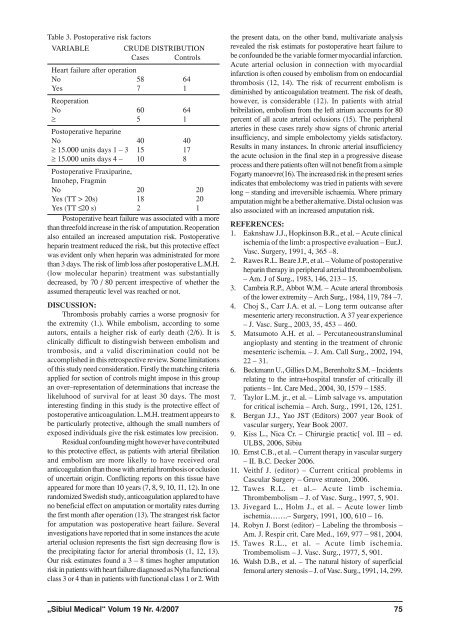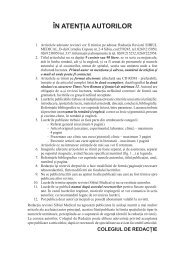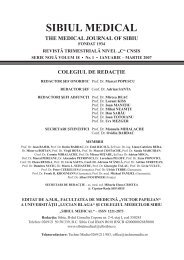You also want an ePaper? Increase the reach of your titles
YUMPU automatically turns print PDFs into web optimized ePapers that Google loves.
Table 3. Postoperative risk factors<br />
VARIABLE CRUDE DISTRIBUTION<br />
Cases Controls<br />
Heart failure after operation<br />
No 58 64<br />
Yes 7 1<br />
Reoperation<br />
No 60 64<br />
≥ 5 1<br />
Postoperative heparine<br />
No 40 40<br />
≥ 15.000 units days 1 – 3 15 17<br />
≥ 15.000 units days 4 – 10 8<br />
Postoperative Fraxiparine,<br />
Innohep, Fragmin<br />
No 20 20<br />
Yes (TT > 20s) 18 20<br />
Yes (TT ≤20 s) 2 1<br />
Postoperative heart failure was associated with a more<br />
than threefold increase in the risk of amputation. Reoperation<br />
also entailed an increased amputation risk. Postoperative<br />
heparin treatment reduced the risk, but this protective effect<br />
was evident only when heparin was administrated for more<br />
than 3 days. The risk of limb loss after postoperative L.M.H.<br />
(low molecular heparin) treatment was substantially<br />
decreased, by 70 / 80 percent irrespective of whether the<br />
assumed therapeutic level was reached or not.<br />
DISCUSSION:<br />
Thrombosis probably carries a worse prognosiv for<br />
the extremity (1.). While embolism, according to some<br />
autors, entails a heigher risk of early death (2/6). It is<br />
clinically difficult to distingwish between embolism and<br />
trombosis, and a valid discrimination could not be<br />
accomplished in this retrospective review. Some limitations<br />
of this study need consideration. Firstly the matching criteria<br />
applied for section of controls might impose in this group<br />
an over–representation of determinations that increase the<br />
likeluhood of survival for at least 30 days. The most<br />
interesting finding in this study is the protective effect of<br />
postoperative anticoagulation. L.M.H. treatment appears to<br />
be particularly protective, although the small numbers of<br />
exposed individuals give the risk estimates low precision.<br />
Residual confounding might however have contributed<br />
to this protective effect, as patients with arterial fibrilation<br />
and embolism are more likelly to have received oral<br />
anticoagulation than those with arterial hrombosis or oclusion<br />
of uncertain origin. Conflicting reports on this tissue have<br />
appeared for more than 10 years (7, 8, 9, 10, 11, 12). In one<br />
randomized Swedish study, anticoagulation applared to have<br />
no beneficial effect on amputation or mortality rates durring<br />
the first month after operation (13). The strangest risk factor<br />
for amputation was postoperative heart failure. Several<br />
investigations have reported that in some instances the acute<br />
arterial oclusion represents the fisrt sign decreasing flow is<br />
the precipitating factor for arterial thrombosis (1, 12, 13).<br />
Our risk estimates found a 3 – 8 times hogher amputation<br />
risk in patients with heart failure diagnosed as Nyha functional<br />
class 3 or 4 than in patients with functional class 1 or 2. With<br />
the present data, on the other band, multivariate analysis<br />
revealed the risk estimats for postoperative heart failure to<br />
be confounded be the variable former myocardial infarction.<br />
Acute arterial oclusion in connection with myocardial<br />
infarction is often coused by embolism from on endocardial<br />
thrombosis (12, 14). The risk of recurrent embolism is<br />
diminished by anticoagulation treatment. The risk of death,<br />
however, is considerable (12). In patients with atrial<br />
bribrilation, embolism from the left atrium accounts for 80<br />
percent of all acute arterial oclusions (15). The peripheral<br />
arteries in these cases rarely show signs of chronic arterial<br />
insufficiency, and simple embolectomy yields satisfactory.<br />
Results in many instances. In chronic arterial insufficiency<br />
the acute oclusion in the final step in a progressive disease<br />
process and there patients often will not benefit from a simple<br />
Fogarty manoevre(16). The increased risk in the present series<br />
indicates that embolectomy was tried in patients with severe<br />
long – standing and irreversible ischaemia. Where primary<br />
amputation might be a bether alternative. Distal oclusion was<br />
also associated with an increased amputation risk.<br />
REFERENCES:<br />
1. Eaknshaw J.J., Hopkinson B.R., et al. – Acute clinical<br />
ischemia of the limb: a prospective evaluation – Eur.J.<br />
Vasc. Surgery, 1991, 4, 365 –8.<br />
2. Rawes R.L. Beare J.P., et al. – Volume of postoperative<br />
heparin therapy in peripheral arterial thromboembolism.<br />
– Am. J of Surg., 1983, 146, 213 – 15.<br />
3. Cambria R.P., Abbot W.M. – Acute arteral thrombosis<br />
of the lower extremity – Arch Surg., 1984, 119, 784 –7.<br />
4. Choj S., Carr J.A. et al. – Long term outcanse after<br />
mesenteric artery reconstruction. A 37 year experience<br />
– J. Vasc. Surg., 2003, 35, 453 – 460.<br />
5. Matsumoto A.H. et al. – Percutaneoustransluminal<br />
angioplasty and stenting in the treatment of chronic<br />
mesenteric ischemia. – J. Am. Call Surg., 2002, 194,<br />
22 – 31.<br />
6. Beckmann U., Gillies D.M., Berenholtz S.M. – Incidents<br />
relating to the intra+hospital transfer of critically ill<br />
patients – Int. Care Med., 2004, 30, 1579 – 1585.<br />
7. Taylor L.M. jr., et al. – Limb salvage vs. amputation<br />
for critical ischemia – Arch. Surg., 1991, 126, 1251.<br />
8. Bergan J.J., Yao JST (Editors) 2007 year Book of<br />
vascular surgery, Year Book 2007.<br />
9. Kiss L., Nica Cr. – Chirurgie practic[ vol. III – ed.<br />
ULBS, 2006, Sibiu<br />
10. Ernst C.B., et al. – Current therapy in vascular surgery<br />
– II. B.C. Decker 2006.<br />
11. Veithf J. (editor) – Current critical problems in<br />
Cascular Surgery – Gruve strateon, 2006.<br />
12. Tawes R.L. et al.– Acute limb ischemia.<br />
Thrombembolism – J. of Vasc. Surg., 1997, 5, 901.<br />
13. Jivegard L., Holm J., et al. – Acute lower limb<br />
ischemia…….– Surgery, 1991, 100, 610 – 16.<br />
14. Robyn J. Borst (editor) – Labeling the thrombosis –<br />
Am. J. Respir crit. Care Med., 169, 977 – 981, 2004.<br />
15. Tawes R.L., et al. – Acute limb ischemia.<br />
Trombemolism – J. Vasc. Surg., 1977, 5, 901.<br />
16. Walsh D.B., et al. – The natural history of superficial<br />
femoral artery stenosis – J. of Vasc. Surg., 1991, 14, 299.<br />
„<strong>Sibiul</strong> <strong>Medical</strong>“ Volum 19 Nr. 4/2007 75




